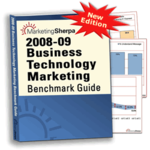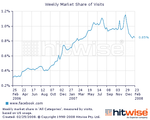Breaking News: Agencies Unhappy with Stock Photos
Posted in: UncategorizedDancing Supermodels and Nipple Electrocution Pay Off
Posted in: Uncategorized
Well, once again, it just goes to show the perennially pointless, annual natter-fest over which Super Bowl spots scored and which didn’t is, well, perennially pointless.
MarketingSherpa Releases Annual Business Technology Marketing Guide
Posted in: UncategorizedGoogle Papers
Posted in: Uncategorized
Architecture of query-specific search recommendation (source: pdf)
A collection of papers written by Googlers has a lot of stuff that points towards a possible direction of search. Since these are all papers published in academic journals, many of them are locked behind publications’ paid subscriptions, but a few are freely available. The one I’m reading now is titled “Retroactive Answering of Search Queries” (pdf); its about identifying queries that have lasting interest and proving answer to these queries at a later date when information becomes available (pictured above).
Teens Speak, Coke Fashions, McDonald’s Mobilizes
Posted in: Uncategorized
If this catches on, you might be wearing that plastic Coke bottle you tossed in the trash a few months back.
Study: Why E-Mails Are Often Misunderstood
Posted in: Uncategorized
image credit: csmonitor
Paper “Egocentrism over E-Mail” (2005, pdf): “People tend to believe that they can communicate over e-mail more effectively than they actually can. Studies further suggest that this overconfidence is born of egocentrism, the inherent difficulty of detaching oneself from one’s own perspective when evaluating the perspective of someone else.”
Statistical Fodder for Your Next Creative Brief!
Posted in: UncategorizedNewsflash! Marketers Must Learn Digital Marketing!
Posted in: UncategorizedWhat? You’ve got to be kidding. What year is it? Oh, it must be 1992 or something because it’s that Total Quality Management verbal diarrhea management consultancy crap all over again. After reading this Advertising Age article penned by…
Newsflash! Marketers Must Learn Digital Marketing! Ad Age Says So!
Posted in: UncategorizedWhat? You’ve got to be kidding. What year is it? Oh, it must be 1992 or something because it’s that Total Quality Management verbal diarrhea management consultancy crap all over again. After reading this Advertising Age article penned by…
Study: Scientific Jargon Sounds Convincing
Posted in: UncategorizedResearchers at Yale established that “explanations of psychological phenomena seem to generate more public interest when they contain neuroscientific information.”
Here’s an automatic computer science paper generator and a postmodern essay generator, both very convincing, the former so much that it got its creators accepted at an academic conference.
— via Neuroscience Marketing
Hybrid Car Owner + Mac User = Contender for Global Dominance
Posted in: UncategorizedA new study by Mindset Media — the new propagandists on the block — finds hybrid car drivers are “more creative” (78 percent more likely) and “less dogmatic” than the rest of the population. Add to that: more open-minded,…
MySpace Head Doctors Invest Blogging with Holistic Properties
Posted in: Uncategorized
A report from Melbourne’s Swinburne University of Technology finds bloggers are less isolated, more connected to a community and more satisfied with friendships. (Probably because, if not for blogging, we would have no friends.)
Facebook Traffic Declines, Time Spent Increases
Posted in: UncategorizedScientists Measure Laughter
Posted in: UncategorizedPink Tentacle: “Researchers at Kansai University have developed a machine that can scientifically measure the quantity of a person’s laughter, as well as distinguish between the real and the fake.
The sensors, which attach to a person’s cheeks, chest and abdomen, take 3,000 measurements per second. Sensor data is relayed to a computer, where it is analyzed by special software that determines the nature of the laugh and assigns a numerical score based on the quantity.”
Would be fun to measure the quality of the canned laughter on TV shows.
SRG Employs Chewbacca Defense to ‘WTF?’ Us into Submission
Posted in: Uncategorized
In early February MarketingVOX published this study about online TV show viewing by Solutions Research Group.
Study: Sad People Spend More
Posted in: UncategorizedAP: A new study shows people’s spending judgment goes out the window when they’re down, especially if they’re a bit self-absorbed. Study participants who watched a sadness-inducing video clip offered to pay nearly four times as much money to buy a water bottle than a group that watched an emotionally neutral clip. (via Neuromarketing)
From the “Misery is not Miserly: Sad and Self-Focused Individuals Spend More” paper: The present findings do, however, allow more than one explanation for the link among sadness, self-focus, and spending. Our working model proposes that sad and self-focused individuals spend more on commodities because they seek self-enhancement. Another possible model is that sad and self-focused individuals experience reduced self-value or sense of entitlement, and therefore value other things more by contrast.” (site, pdf)
Microsoft Shows Off Next-Gen Ad Tech
Posted in: UncategorizedVideo demo: “Contextual Ads for Video. Through speech recognition, this technology enables ads to be dynamically served based on the content discussed in the video.” (Another demo)
Microsoft showcased a series of new technologies from their adCenter Labs during the lab’s Demo Fest.
Press release: “The technologies highlighted at this event included the latest advances and algorithms in content analysis and computer vision for video and images, speech recognition for contextual video ads, and advanced marketing intelligence that enable enhanced audience insight and better targeting capabilities for advertisers.”
Some of the geekier stuff:
“Contextual Ads for Video. Through speech recognition, this technology enables ads to be dynamically served based on the content discussed in the video.
Intelligent Bug Ads. By using a computer vision algorithm to calculate the least intrusive spot in the video, it approximates human judgment and places the ad in the video where it is least likely to interfere with the consumer’s viewing experience.
Visual Product Browsing. This tool uses computer vision algorithms to browse and categorize images as a human might, without the need for manual data tagging.
Content Analysis Engine. This technology uses advanced algorithms to automatically extract and categorize information from search queries and Web page contents to better understand user intent and minimize search engine marketing complexity.
Content Detection in Sub-documents. This technology identifies sensitive or unsuitable content such as pornography, weapons or negative sentiments that advertisers would not likely want to be associated with, and automatically blocks contextual ads related to that content.”
Scientist Debunks “The Influentials” Theory
Posted in: UncategorizedFast Company runs an article in which Duncan Watts, a network-theory scientist, puts to test the idea that trends are sparked by a handful of highly connected individuals, or the influentials, as they have become known after the bestsellers The Tipping Point and The Influentials.
“Watts believes […] a trend’s success depends not on the person who starts it, but on how susceptible the society is overall to the trend–not how persuasive the early adopter is, but whether everyone else is easily persuaded. And in fact, when Watts tweaked his model to increase everyone’s odds of being infected, the number of trends skyrocketed.
If society is ready to embrace a trend, almost anyone can start one–and if it isn’t, then almost no one can,” Watts concludes. To succeed with a new product, it’s less a matter of finding the perfect hipster to infect and more a matter of gauging the public’s mood. Sure, there’ll always be a first mover in a trend. But since she generally stumbles into that role by chance, she is, in Watts’s terminology, an ‘accidental Influential.'”
Watts has published several books on the subject, including Six Degrees: The Science of a Connected Age.
Update [Jan 27 ’08]: Mike Arauz from Deep Focus responds.
My own beef with the theory of influentials is its implicit assertion, in my understanding of The Tipping Point, that if you have influence over a certain social network, this influence will have the same weight over the entire range of topics. I don’t know if this Absolute Influence exists, and my own daily experiences offer nothing to support the idea: it is not a given that someone who is an apparel fashion trendsetter in one particular network will be have the same influence over the choice of others’ plasma TVs, for example. Likewise, one’s influence will also vary across different networks, which makes identifying and targeting The Influentials a much more complex task than it is suggested by the theory advocates.
Study: Store Ads Influence Shoppers’ Goals
Posted in: Uncategorized“Researchers from MIT have shown that people are most susceptible to be influenced by advertisers and promotions at the entrance of the store. According to the scientists, people usually don’t have their shopping goals very clearly pre-determined; they decide not only what specific product to buy but also what kind of product they want to buy during their wondering through the supermarket’s aisles.”
– Softpedia





